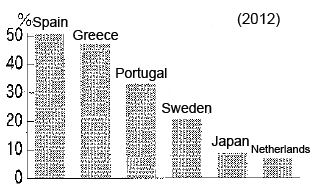After the global financial crisis in 2008 subsided, many industrialized nations suffered high unemployment rates among the young working population. When an economy is in a recession, young workers who are about to enter the labor market are the ones who are affected the most.
Spain was hit especially hard, with the unemployment rate reaching 50.5% for male workers aged 20 to 24 in 2012. High unemployment rates for young workers also have been seen in other southern European countries such as Portugal, Italy, and Greece. By contrast, the rate was not as high in northern European nations.
One important factor in considering such differences in the unemployment rates for young workers across countries is institutional rigidity in the labor market, especially in how strict is the restriction on employment termination in each country. As the restrictions become more rigid, fewer workers change or quit jobs, lowering the labor market mobility. This is why young workers are severely affected, as they are inherently very mobile in the labor market.
Another important factor is the differences in how each country responds to macroeconomic shocks such as financial crises. In countries where the restriction on employment termination is stringent, companies respond to such negative shocks by holding back on hiring young people as they cannot lay off middle-aged or older workers. Thus, the unemployment rate for young people becomes sensitive to economic trends. On the other hand, in countries like the United States where the restriction on employment termination is less strict, unemployment rates for workers of all ages from the young to the middle-aged and elderly change similarly.
In the empirical research that I conducted with Kyushu University Assistant Professor Tetsushi Murao using data from the Organisation for Economic Co-operation and Development (OECD) member counties, we found that young workers serve to absorb negative macroeconomic shocks in countries where the restriction on employment termination is stringent.

* Translated by RIETI from the original Japanese "Yasashii Keizaigaku" column in the October 24, 2013 issue of Nihon Keizai Shimbun.


